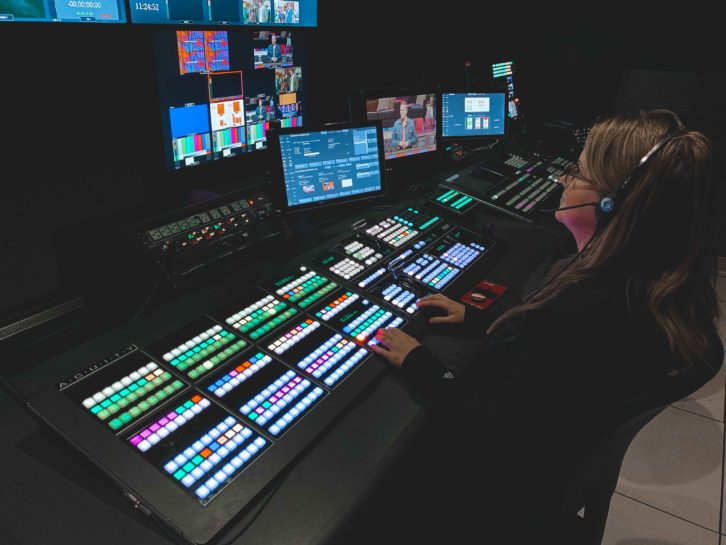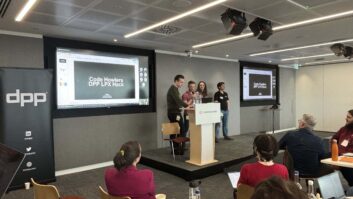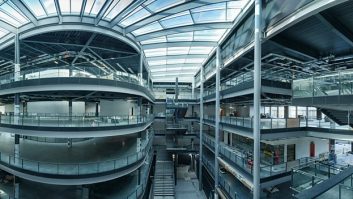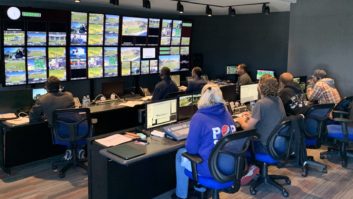The DPP has identified five key production models that aim to address the four primary constraints faced by producers across the industry.
In its latest report, the DPP outlines the key models of live production. The report also offers a look at why broadcasters and production houses may choose one model over another.
The models outlined in the “Going Live & Remote” Insight Report, sponsored by Ross Video, are: On Location, Remote Controlled, Centralised, Distributed and Cloud.
On Location is the traditional model of production that the industry has used for decades, in which content acquisition, signal processing, and production are all co-located at either a studio or an outside broadcast truck or location.
Remote Controlled production sees operators and control surfaces shifted to offsite locations – such as the central home of a broadcaster – while processing and acquisition remain on-location. This, according to the report, has seen significant growth in popularity due to restrictions caused by the Covid-19 pandemic.
A Centralised model moves signal processing and production control to a central hub as well. This has significant implications for bandwidth requirements, but allows for lower capital investment into live event. The DPP expects this model to grow dramatically in the next two years.
A Distributed model also uses centralised processing but, by enabling crews to remotely control production from several hubs (as opposed to one central location), it also provides additional flexibility and potential travel reduction. Using multiple production hubs may add complexity to the transport layer, but it allows talent to work from any location.
One of the key areas of discussion at trade shows in recent years has been Cloud production, which sees some or all the signal processing done in the cloud. This model, which is set to join Centralised production in dominating the industry, would be controlled remotely and offers similar benefits to the Distributed model.

The DPP said: “While it is true to say that remote live production has grown a great deal, there is still a huge difference in technology and workflow between a major sporting event being produced from the broadcaster’s headquarters, and an episode of a chat show in which the guests are filmed at home via video conferencing. Perhaps therefore there is no common understanding or language when it comes to describing different models of remote live production.
“For the first time, the DPP has identified five clearly defined models of live production. Each has its own advantages and disadvantages, and its own specific technical and operational considerations. By laying them out in plain English, we aim to arm producers with the knowledge needed to choose the most appropriate model every time.”
The report was put together by communicating with people working across the industry and taking in their views of remote live production.
Having identified the key models of production, the DPP also aims to offer guidance for companies choosing which model best suits their needs, by laying out four primary constraints and considerations when making this decision.
These are:
- Content: Creative potential is maximised when the production team can communicate seamlessly. This can be achieved remotely, but there are still advantages to having the bulk of the crew in one location as they would be in the On Location or Centralised production models.
- Bandwidth: Bandwidth is a key limiting factor at many sites, and connectivity is now part of the site assessment for outside broadcasts. When bandwidth is constrained, it is preferable to use models that avoid transporting raw camera feeds, such as On Location or Remote Controlled production.
- Latency: Latency is a key consideration for all remote productions but is especially important for systems such as intercom. Latency can be managed in each remote production model but is likely to be minimised when using those with simpler network topologies, like On Location and Centralised production.
- Cost: Remote production reduces travel and transport costs, and the most effective models enable greatly increased utilisation of equipment and crew. When considering new build infrastructure there are favoured models for cost-effectiveness: Centralised and Cloud production.
With the Coronavirus pandemic, the industry has adapted by developing creative new tools and solutions enabling collaboration to continue. These tools are mostly built with low latency and high production values in mind, supporting broadcasters and production companies looking to create the same high-quality content they did before social distancing rules.
Ross Video customers use products like the Ultrix Acuity production platform and the DashBoard control system to enable their remote productions around the world.
Ross also offers key solutions in this space, such as its Interstellar platform. Interstellar provides an intuitive user experience that allows remote contributors to send high quality, low latency video to existing production infrastructure. Interstellar integrates with existing production switchers, routers and workflows through standard SDI connectivity.
If you’re looking for a way to improve your production model, Ross solutions have the flexibility to meet your needs – whatever they may be. Our team can provide expert guidance and solutions to make your project a success. Email us: [email protected].







